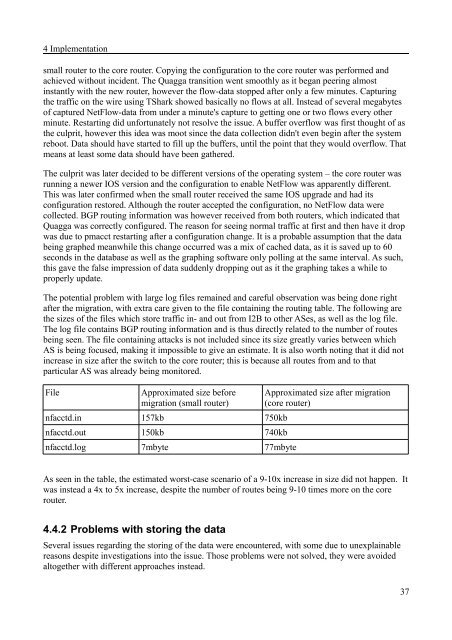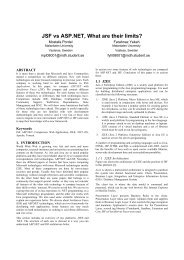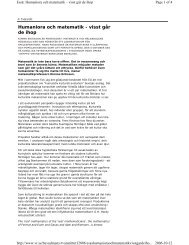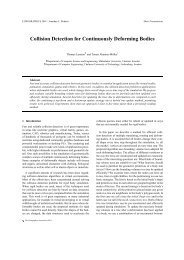Implementation of data collection tools using NetFlow for statistical ...
Implementation of data collection tools using NetFlow for statistical ...
Implementation of data collection tools using NetFlow for statistical ...
Create successful ePaper yourself
Turn your PDF publications into a flip-book with our unique Google optimized e-Paper software.
4 <strong>Implementation</strong><br />
small router to the core router. Copying the configuration to the core router was per<strong>for</strong>med and<br />
achieved without incident. The Quagga transition went smoothly as it began peering almost<br />
instantly with the new router, however the flow-<strong>data</strong> stopped after only a few minutes. Capturing<br />
the traffic on the wire <strong>using</strong> TShark showed basically no flows at all. Instead <strong>of</strong> several megabytes<br />
<strong>of</strong> captured <strong>NetFlow</strong>-<strong>data</strong> from under a minute's capture to getting one or two flows every other<br />
minute. Restarting did un<strong>for</strong>tunately not resolve the issue. A buffer overflow was first thought <strong>of</strong> as<br />
the culprit, however this idea was moot since the <strong>data</strong> <strong>collection</strong> didn't even begin after the system<br />
reboot. Data should have started to fill up the buffers, until the point that they would overflow. That<br />
means at least some <strong>data</strong> should have been gathered.<br />
The culprit was later decided to be different versions <strong>of</strong> the operating system – the core router was<br />
running a newer IOS version and the configuration to enable <strong>NetFlow</strong> was apparently different.<br />
This was later confirmed when the small router received the same IOS upgrade and had its<br />
configuration restored. Although the router accepted the configuration, no <strong>NetFlow</strong> <strong>data</strong> were<br />
collected. BGP routing in<strong>for</strong>mation was however received from both routers, which indicated that<br />
Quagga was correctly configured. The reason <strong>for</strong> seeing normal traffic at first and then have it drop<br />
was due to pmacct restarting after a configuration change. It is a probable assumption that the <strong>data</strong><br />
being graphed meanwhile this change occurred was a mix <strong>of</strong> cached <strong>data</strong>, as it is saved up to 60<br />
seconds in the <strong>data</strong>base as well as the graphing s<strong>of</strong>tware only polling at the same interval. As such,<br />
this gave the false impression <strong>of</strong> <strong>data</strong> suddenly dropping out as it the graphing takes a while to<br />
properly update.<br />
The potential problem with large log files remained and careful observation was being done right<br />
after the migration, with extra care given to the file containing the routing table. The following are<br />
the sizes <strong>of</strong> the files which store traffic in- and out from I2B to other ASes, as well as the log file.<br />
The log file contains BGP routing in<strong>for</strong>mation and is thus directly related to the number <strong>of</strong> routes<br />
being seen. The file containing attacks is not included since its size greatly varies between which<br />
AS is being focused, making it impossible to give an estimate. It is also worth noting that it did not<br />
increase in size after the switch to the core router; this is because all routes from and to that<br />
particular AS was already being monitored.<br />
File Approximated size be<strong>for</strong>e<br />
migration (small router)<br />
nfacctd.in 157kb 750kb<br />
nfacctd.out 150kb 740kb<br />
nfacctd.log 7mbyte 77mbyte<br />
Approximated size after migration<br />
(core router)<br />
As seen in the table, the estimated worst-case scenario <strong>of</strong> a 9-10x increase in size did not happen. It<br />
was instead a 4x to 5x increase, despite the number <strong>of</strong> routes being 9-10 times more on the core<br />
router.<br />
4.4.2 Problems with storing the <strong>data</strong><br />
Several issues regarding the storing <strong>of</strong> the <strong>data</strong> were encountered, with some due to unexplainable<br />
reasons despite investigations into the issue. Those problems were not solved, they were avoided<br />
altogether with different approaches instead.<br />
37

















